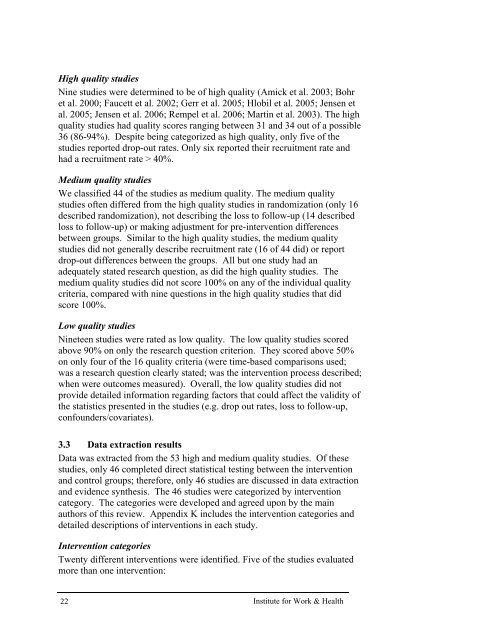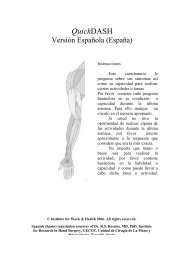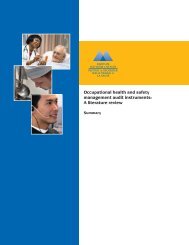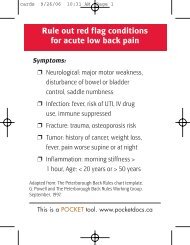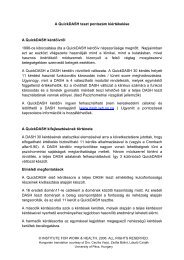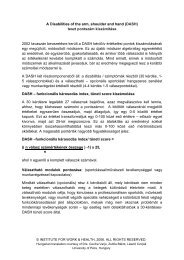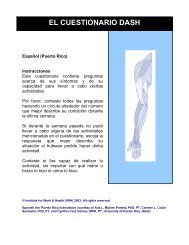A systematic review of injury/illness prevention and loss control ...
A systematic review of injury/illness prevention and loss control ...
A systematic review of injury/illness prevention and loss control ...
- No tags were found...
Create successful ePaper yourself
Turn your PDF publications into a flip-book with our unique Google optimized e-Paper software.
High quality studiesNine studies were determined to be <strong>of</strong> high quality (Amick et al. 2003; Bohret al. 2000; Faucett et al. 2002; Gerr et al. 2005; Hlobil et al. 2005; Jensen etal. 2005; Jensen et al. 2006; Rempel et al. 2006; Martin et al. 2003). The highquality studies had quality scores ranging between 31 <strong>and</strong> 34 out <strong>of</strong> a possible36 (86-94%). Despite being categorized as high quality, only five <strong>of</strong> thestudies reported drop-out rates. Only six reported their recruitment rate <strong>and</strong>had a recruitment rate > 40%.Medium quality studiesWe classified 44 <strong>of</strong> the studies as medium quality. The medium qualitystudies <strong>of</strong>ten differed from the high quality studies in r<strong>and</strong>omization (only 16described r<strong>and</strong>omization), not describing the <strong>loss</strong> to follow-up (14 described<strong>loss</strong> to follow-up) or making adjustment for pre-intervention differencesbetween groups. Similar to the high quality studies, the medium qualitystudies did not generally describe recruitment rate (16 <strong>of</strong> 44 did) or reportdrop-out differences between the groups. All but one study had anadequately stated research question, as did the high quality studies. Themedium quality studies did not score 100% on any <strong>of</strong> the individual qualitycriteria, compared with nine questions in the high quality studies that didscore 100%.Low quality studiesNineteen studies were rated as low quality. The low quality studies scoredabove 90% on only the research question criterion. They scored above 50%on only four <strong>of</strong> the 16 quality criteria (were time-based comparisons used;was a research question clearly stated; was the intervention process described;when were outcomes measured). Overall, the low quality studies did notprovide detailed information regarding factors that could affect the validity <strong>of</strong>the statistics presented in the studies (e.g. drop out rates, <strong>loss</strong> to follow-up,confounders/covariates).3.3 Data extraction resultsData was extracted from the 53 high <strong>and</strong> medium quality studies. Of thesestudies, only 46 completed direct statistical testing between the intervention<strong>and</strong> <strong>control</strong> groups; therefore, only 46 studies are discussed in data extraction<strong>and</strong> evidence synthesis. The 46 studies were categorized by interventioncategory. The categories were developed <strong>and</strong> agreed upon by the mainauthors <strong>of</strong> this <strong>review</strong>. Appendix K includes the intervention categories <strong>and</strong>detailed descriptions <strong>of</strong> interventions in each study.Intervention categoriesTwenty different interventions were identified. Five <strong>of</strong> the studies evaluatedmore than one intervention:22 Institute for Work & Health


